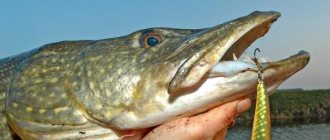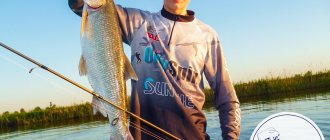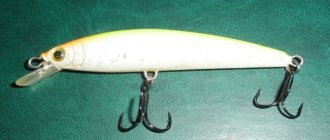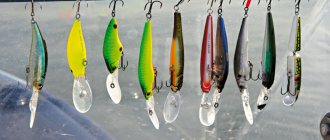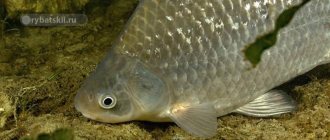Crank is a spinning bait, wobbler, which is one of the first to be added to the range of novice fishermen. The choice in its favor is not in vain. A wobbler of this class is easy to master, since it does not require ornate animation techniques, like a minnow. In addition, its versatility and catchability make it possible to catch a predator in any body of water.
The crank class wobbler came to us, traditionally, from Western colleagues. This bait was originally used for bass fishing. Having fallen into the hands of domestic spinning anglers, the crankbait began to be used for fishing for white predators, perch, pike perch, and catfish. Ultralight models turned out to be capable of effectively catching even peaceful fish.
Today there is no fisherman who does not have a set of cranks in his arsenal. These baits are suitable all year round, since their persistent aggressive play turns on not only an active predator, but also provokes sluggish or well-fed fish to bite. Definitely, beginners should not pass by wobblers of this class. We'll look at how to fish with a crank below.
What is a crank?
Crank (English crank) is a wobbler that has its own game. Almost all models belonging to this class are endowed with active noisy movements. To animate the bait, you do not need to perform any animation techniques; it works steadily and catches fish on the banal monotonous winding of the reel.
The crankbait has a short body that tapers sharply towards the tail. The size of the wobbler blade and its angle of inclination depends on the working horizon. Many models have a balancing system inside, which also acts as a noise chamber. Thanks to this, the bait makes loud sounds in the water, attracting predatory fish from a long distance.
All cranks are equipped with hooks. Large and medium models have two tees located in the belly of the bait and in the tail. Ultralight wobblers, as a rule, are equipped with one located at the rear.
Crank classification
Cranks, like any artificial spinning bait, can be classified according to different criteria:
- according to form;
- by depth;
- to size;
- by buoyancy.
Classification of rolls by shape
Based on their shape, all crank wobblers can be divided into three large groups. This parameter determines the scope of application of the bait, the features of fishing with it and other subtleties, knowing which, the angler can use it as productively as possible.
- Fat. Translated as “fat man.” The most massive group among cranks. These are universal wobblers, suitable in any conditions. They hold the current perfectly and do not lose their play when moving across the stream. They are distinguished by impressive long-range properties and noisy aggressive behavior, attracting predators from afar.
Photo 1. Seductive fat man - fat.
- Flat. They have a flat body. The vibration frequency during wiring is average. They are not so stable in strong flows, therefore they are recommended for slow flows or standing reservoirs.
- Shad. Translated as "herring". Many models in this group are a kind of symbiosis of crank and minnow. The bait allows for different animation techniques, including jerking elements. Can work on currents and in closed reservoirs.
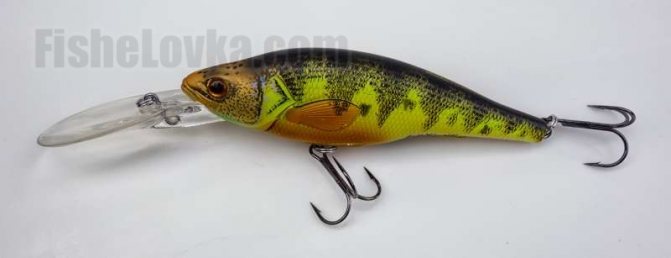
Photo 2. Shad has a slightly elongated shape.
Important! In some classifications of wobblers, shads are considered a separate class of bait, along with crankbaits and minnows. This is not a mistake, but the opinion of many anglers. Moreover, the essence does not change.
Classification of cranks by depth
In terms of depth, crank-class wobblers, like other bulky solid baits, are:
- superficial (designated SSR),
- subsurface (SR),
- deepwater (MR, MDR, DR, DDR).
Classification of rolls by size
By size they can be divided into:
- ultralight;
- light;
- average;
- large.
The latter, by the way, are not so many. They are used primarily in trolling fishing in vast water areas, designed for impressive depths and weighty trophies.
Classification of cranks by degree of buoyancy
According to the degree of buoyancy, cranks are:
- floating;
- drowning;
- suspenders (very rarely).
The first ones are the most common and are used everywhere. The latter are used in currents because they better maintain a given horizon in a strong current. There are few suspenders among this class of wobblers. Mostly these modifications are found among shad, which can be twitched like minnows.
Catching pike with cranks: features, secrets and subtleties of fishing
The catchability of this bait depends not only on the skills of the fisherman, but also on the correct approach to spinning fishing. You need to take into account all the subtleties and secrets to achieve the greatest success. What recommendations exist for crank fishing?
- How the bait will play depends on the shape, size, and materials from which it is made. When fishing for pike, you should give preference to low-frequency vibrations of the bait. Some types of cranks can play themselves and do not require any effort from the spinner, while others have to be animated using all your experience.
- If you have to catch pike during the current, then it is better to use models with a noise chamber. It is preferable to have one noise ball in the chamber. This design will attract more representatives of the fish kingdom to the bait.
- The color of the crank is selected taking into account the conditions in which fishing takes place. If the reservoir has clean and clear water, then it is not necessary to choose bright models. And in muddy water they will come in handy. The presence or absence of the sun should also be taken into account, since the rays make their own adjustments to the choice of color.
- It is believed that the best wiring for a crank is uniform. But this does not mean that you can only use it. Each angler chooses the one he likes. The main thing is to have good command of one or another species so that the bait shows an interesting and believable game.
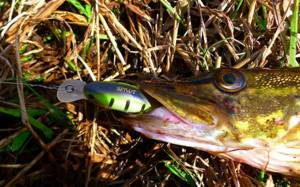
Spinning fishing involves the use of sinking crank wobblers. An attractive game is ensured by constantly pulling the rod and reeling in the fishing line.
Important! If the pike is passive during fishing, then it is necessary to observe pauses when retrieving. Then the predator has more opportunities to attack the bait.
Types of wiring and equipment

Since cranks have their own game, the choice of spinning rod is important only in terms of the blank’s ability to cast. It's best to stick with an average length blank of 8-9 feet (240-270 centimeters).
It is better to use a multiplier with a thin braid wound on it as a reel. With its help, the optimal casting distance is achieved. If you use monofilament fishing line, it will diversify the game. This equipment is suitable for all types of wiring.
When catching toothy predators using a spinning rod, the following types are used:
- “Uniform wiring” is universal in its use, for various types of baits. It is this that is most often used by beginners or experienced fishermen when mastering a new wobbler model. This technique can be varied by the speed of movements. Some cranks play well when reeled slowly, while others play well when reeled vigorously.
- “Stop and Go” is the second most popular fishing technique among anglers. Here you can use pauses of different durations and vary the coil speed. With this method of playing, you can use a ragged rhythm.
- “Twitching” is also suitable for such catchy baits. It is recommended to use flats.
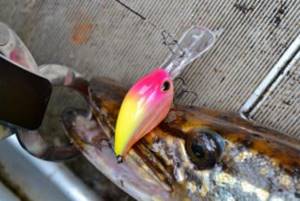
Carefully approach the choice of gear and bait, and then a good catch will be guaranteed. Feel free to go to the reservoirs and conquer the spotted predator with your knowledge and skill. Have a nice catch!
Where to use cranks?
Crank fishing, as mentioned above, is possible in different types of reservoirs. These baits work successfully on rivers with any current strength, are used in lakes, quarries, swamps and toad grasses, and show their best qualities when fishing in reservoirs.
In our latitudes, the main objects for fishing with crank wobblers are:
- perch;
- chub;
- pike;
- asp.
Deep-sea models capable of fishing channel holes and ditches are good for catching pike perch and catfish. Miniature wobblers regularly catch ide, rudd, dace, sabrefish and other representatives of the ichthyofauna. You can even catch bleak or roach with the smallest and weightless baits.
The best time for fishing with fats and other types of cranks is summer. During this period, the fish are most active and respond well to the aggressive behavior of wobblers. In cold water, bites occur less frequently, but still, if you present the bait correctly, you can return home with a decent catch.
Video: cranking pike
To learn how to catch pike using cranks, watch the following video:
In general, cranks for catching toothy lures have shown themselves to be productive baits; with the right tactics, they catch no worse than other wobblers, especially the minnow class. The top cranks for pike presented earlier are approximate, since the same bait can work in different ways, it all depends on the conditions and place of fishing, on the technique and skill of the fisherman, and such an indicator as luck has not been canceled either.
Views: 588
Similar articles:
- Top wobblers for pike. The best wobblers for pike fishing 2019-2020 A wobbler is a solid bait for fishing with a spinning rod or...
- Wobblers for pike. Rating of the most effective lures Top 10 Rating of the best wobblers for catching trophy pike with a spinning rod. Review…
- Marking of wobblers: and their classification A wobbler is a type of solid bait that looks like a small fish,...
- Fishing for pike by twitching. Top 5 best wobblers for twitching Twitching is a relatively new and quite effective fishing technique for…
How to fish with cranks correctly?
The basic movement of the crank is uniform at the same speed throughout the feed. There are two opinions regarding the intensity of fishing line reeling:
- Some recommend feeding the bait as slowly as possible so that it works to the point of failure.
- The latter advise, on the contrary, to rotate the reel handle as quickly as possible so that the crank makes strong vibrations, attracting fish from afar.
Both options have the right to life. You need to constantly experiment with the speed of the retrieve, choosing the optimal one for the given conditions and the mood of the predator. Moreover, depending on the angle of the crank feed, the intensity of winding the cord on the spool changes.
The cranks are unique in that they work stably at different wiring angles. Wobblers can be caught upstream, against the current, across the stream, and are stable when fed in a drift or in an arc. They can be rafted over long distances to promising points, and then driven at the desired pace.
Advice! Shads can be carried out with jerking elements. Unlike many minnows, they catch both on a monotonous serve and on twitching.
Floating models are productive on stop&go fishing, which consists of periodic stops while reeling in the fishing line. At this time, the bait floats up, swaying. This option often works for sluggish, inactive fish. Used for fishing for perch, pike perch and pike. The white predator rarely responds to such animation.
Herbaceous watering
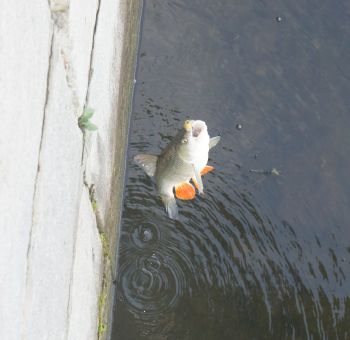
By the second ten days of July, a variety of algae grow abundantly on the shallows of the Moscow River. These include “burdocks” that come to the surface and bottom grass. In some places they form strips thirty meters or more wide that run for a considerable distance along the shore. The typical depth for such irrigation is one and a half to two meters. And taking into account the fact that you need to cast further away, wobblers of medium deep water are more appropriate here. Moreover, where there is grass, there is no need to scrape along the bottom - the wobbler should go somewhere half-water.
The visual factor when fishing on grassy areas is very important. We see, of course, the grass itself, and (very desirable!) a wobbler, and quite often a predator coming out behind it. Here, just like under the “wall”, sometimes it’s possible to catch it after a single exit. The difference is that in the grass the fish does not immediately move away from the point where it found itself. Therefore, catching happens not only on the first cast, but also on the fourth or fifth. Perhaps even changing the bait - to a different wobbler or not a wobbler at all.
If we talk about some other subtleties of “grass” fishing, then the choice of wobbler buoyancy is very important here. Some cranks are made in a sinking version or close to suspenders. In our case they are less relevant. Better - confidently floating. Why? It's simple. Very often, along the fishing path there is an obstacle in the form of grass, which does not reach the surface by 30 - 40 centimeters. A wobbler that is not buoyant enough will certainly “drive” into these algae. Whereas for a swimmer, we give him a couple of seconds to ascend, carefully drag him over the obstacle and continue guiding.
Another subtlety is the actual stopping of the wobbler. The stop-and-go technique, as you know, is often used when fishing with minnow wobblers. With floating cranks there seems to be no particular reason for retrieving with stops, since such a wobbler goes up immediately when stopping. But in this case, we do not count on a bite “in the third second,” as it often happens with minnows. For a crank, a half-second stop is enough to provoke the predator following it to attack. Unless, of course, he is generally inclined to be provoked. What I mean is that sometimes it’s worth trying driving with stops, there should be a few of them - 2-3 per drive. Most often, this technique works in October, when the water is already cool.
Famous crank models
This type of hard plastic bait is produced by every manufacturer. The fishing market offers the most diverse models, differing in size, color, and performance characteristics. Sometimes making meaningful choices is difficult. Below we list some popular crankbaits that are known to most anglers and have proven themselves to be universal, catchy and stable wobblers.
Smith Camion
Photo 3. Wobbler Smith Camion.
A family of miniature wobblers designed for ultralight. The baits were originally developed for trout fishing. In our reservoirs they turned out to be unusually catchy for white predators, perch, and medium-sized pike. Chub fishing enthusiasts especially loved the model. In northern latitudes, grayling and whitefish take it well.
Cranks from this series are available in different sizes and weights. In addition, individual models have different depths. The line includes both surface baits and diving baits at 2-3 meters. The wobbler is stable in any current and works stably at different fishing speeds.
Jackall Cherry
Photo 4. Wobbler Jackall Cherry
Another popular line of lures aimed at light spinning rods. Available in various modifications, differing in size, weight and working horizon. It has good flight performance, is stable in different currents and at any feed speed.
In our conditions, the crank of this model is used for hunting large chub and ide, asp and perch. Deep-sea modifications can tempt pike perch and medium-sized catfish. Of course, the pike will not miss the bait.
Yo-Zuri 3D Crank
Photo 5. Wobbler Yo-Zuri 3D Crank.
A universal crank, created for “adult” spinning and trolling. When retrieved, it dives to depths of up to 4 meters, provoking the predator hiding in the shelter to grab it. It has a wide, noisy game, is stable at fast retrieve speeds, and is not afraid of strong currents. Quickly reaches the given horizon and does not leave it throughout the entire feed.
In our reservoirs, this crank catches pike, pike perch, large perch and catfish well. In spring and autumn, it can tempt an asp that has sunk into the middle layers or to the bottom. On large rivers, a wobbler is used to hunt for trophy chub and ide.
Bomber Fat A
Photo 6. Wobbler Bomber Fat A.
A well-known series of lures that is used in spinning and trolling. Small models have proven themselves well in ultralight. They are suitable for fishing at shallow depths, tempting chub, perch, rudd, ide, small pike, dace and saberfish. Large modifications are used for hunting pike perch, catfish, trophy humpback salmon and heavy, toothy beast.
The crank has an aggressive game with a high oscillation frequency. It behaves quite confidently in a strong flow and allows the use of fast movements. Flight performance is average, but the wobbler more than compensates for this with excellent catchability and versatility.

